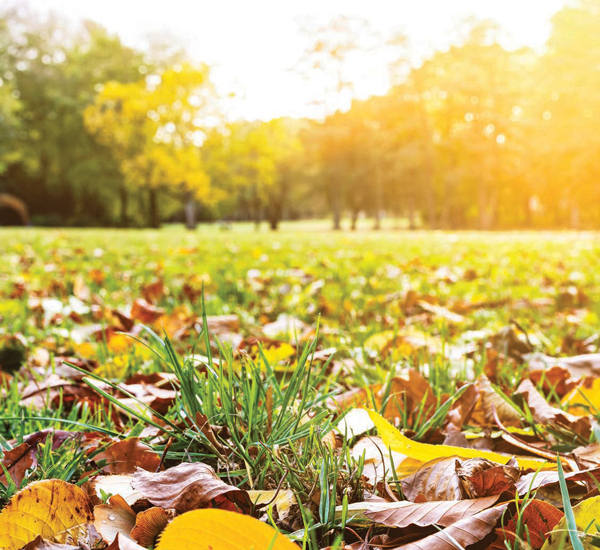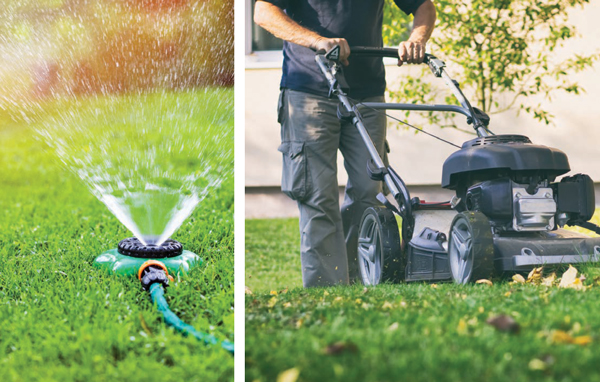Fall Lawn Care | Getting Your Grass Ready for Winter

Fall is an important season when it comes to your lawn. Although the weather is turning cooler and your grass isn’t growing as fast, it’s preparing itself for dormancy by absorbing as much moisture and as many nutrients as possible before the winter months. There are several ways to encourage and assist your lawn in this preparation, and all of them can be done pretty easily by most homeowners. Putting in a little extra time and effort now will ensure a healthier and more beautiful lawn come spring.
Keep the mower going, water flowing
Your grass will continue to grow until late fall, so keep mowing until then. If grass is left too long, it could develop mold or fungus; if it’s cut too short, it will be stressed by cold weather, so it’s important to maintain the correct length. For the last few cuts of the season, lower the blade of your lawnmower to allow more sunlight to reach the crown of the grass and keep it from turning brown. Never trim off more than one-third of the length of the grass at any one time, and never cut it shorter than 2 to 2 1/2 inches in length. Continue watering your lawn if it needs to recover from drought or summer stress. A healthy lawn needs 1 inch of water per week, and the best time to water is in the morning. This will help the grass get stronger for the winter and dissolve any fertilizers that need to soak into the ground. Try to keep your lawn free of leaves and debris throughout the fall. Leaves left on the grass will get wet from dew and rain and form a covering that will block light and cause diseases, which can ultimately kill your grass.
Aerate, overseed and feed
Aeration of your yard is best done in the fall, when temperatures have cooled down and the soil is still warm. Aerating is a process whereby holes are punched in the soil and plugs of dirt are extracted and left behind. It helps loosen the soil, and allows oxygen, water and fertilizer to better reach the roots of the grass, aiding the development and healthy growth of those roots before the winter months. It also allows hearty roots to permeate the soil, thus thwarting the growth of weeds in the spring. Aerating can be done by a landscape professional or you can rent an aerator at your local hardware store. Be sure to use an aerator that extracts the plugs, not just punches the holes. Just punching holes will cause compaction of your lawn over time, making it harder for your lawn to absorb the nutrients it needs to survive.
Putting in a little extra time and effort in the fall will ensure a healthier and more beautiful lawn come spring.
It makes sense to overseed your lawn following aeration. Some of the seeds will fill the holes and sprout, but even the seeds scattered on top of the lawn will grow and make for a lush lawn. There are always new varieties of grass seed, so you can choose the right one for your specific needs.
If you fertilize your yard only once a year, it should be done in mid to late fall. Even though the grass seems to be growing slower, the roots and rhizomes (plant stem below the surface) are still growing fast and need nutrients to support them through the fall and then later in spring when growing season begins. A good fertilizer has a blend of nitrogen, phosphorous and potassium. You can have your soil tested to see what exactly your lawn needs, or you can ask the professionals at any nursery or garden center. If you prefer to use an organic fertilizer, choose one that is labeled “natural organic” and “slow release.” These natural products contain nutrients for your lawn that come from plants and animals, such as seaweed and bone meal. A walk-behind drop spreader is the best way to get full coverage of either kind of fertilizer on your lawn, and should be done three weeks before the last mowing of the season.
A little effort goes a long way
Don’t panic if your yard is in major disrepair and you are overwhelmed at the idea of spending your entire fall trying to fix it. A beautiful yard takes time to cultivate, and you can always start small by filling in any bare spots in your lawn. Simply purchase a lawn repair mix, which contains seed, fertilizer and mulch, then rake the area, apply the repair mix and water every other day for a couple of weeks.
You can also improve the look of your yard by eliminating weeds. There are numerous products on the market that will feed your lawn and control weeds at the same time. A healthy lawn will prevent those pesky plants from taking root. ✦
Aerate, dormancy, Fall Lawn Care, Fertilize, nitrogen, phosphorous, potassium









